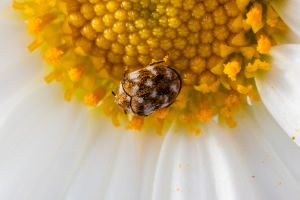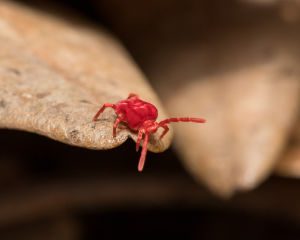Lions and Lambs – Changing Pest activity in March
By Zachary Ciras on March 14, 2022.
March is the month of the official start of spring. In new England, that means we keep one eye open looking for the next storm of the century, as many have occurred in the first part of March, and one eye on the Crocus and Daffodils peaking through the soil, signaling the upcoming new life and good weather. This season is transitional also for pests in Massachusetts and New Hampshire as well.
Ticks
As soon as the snow melts, the overwintering ticks emerge, searching for their first meal of the season. Often, that’s from a mouse, bird, or squirrel. As homeowners begin to ready their yards for warm outdoor fun, keep a vigilant awareness for ticks, especially at the shrub lines and tall grasses on your property.
Early Pollinators

varied carpet beetle on a white daisy
Many species of bees and wasps begin their pollination work in March. Bees and wasps are not the only pollinators we see in the spring. Carpet beetles, Larder beetles, and more March insects awaken to search out the pollen and nectar of early plants.
Termites
The Eastern Subterranean Termite (reticulitermes flavipes) is one structural pest which can make a big impression in March. Termite reproductive swarmers, or alates, emerge from the soil or their hidden worksites (which can be within your home) when the colony has reached maturity, the relative ground temperature is warm enough, and often the day after a rain. We actually start seeing swarms occur near homes and under slabs in February, but March is often the conspicuous beginning of the swarming season.
Ants
Ants of many varieties make themselves known in March. Carpenter ants begin to scout for their seasonal nesting site after overwintering. Citronella ants begin their brooding season from beneath the soil, sometimes alarming homeowners with large numbers of winged individuals suddenly appearing. Even smaller ants, like pavement ants and odorous house ants begin their active season in earnest in March.
Clover mites and springtails

Red Clover Mite crawling over brown foilage
Clover mites, a very tiny mite which feeds normally in your lawn, may begin to migrate into or onto your home at this time of year. Observations of clover mites in the home tend to follow heavy rains, hot weather, lawn treatments, or changes in the season. Squishing these plant feeders will leave red stains, but if you can control your urges, they should dehydrate with a few days.
Overwintering invaders emerge!
Many insects attempted to make their way into your home in the fall, whether or not you were aware. Our Preventative Maintenance Program goes a long way to prevent their entry, but even the best prevention may leave access for a few relatively harmless insects. Ladybugs are one insect which tries to lay dormant inside your walls, attic, or voids. These will begin to emerge and try to escape back outside when the sun hits the house at the sort of angles only March can produce. Right with the Ladybugs are Brown Marmorated Stink Bugs, Western Conifer Seed Bugs, and boxelder bugs. Mechanical exclusion, caulking and painting, screen repair, and an effective chemical barrier work together to mediate these and other insect occurrences.
March may be in like a lion and out like a lamb, but pest activity continues to expand until the fall frosts. The pest professionals at Colonial are prepared to best protect your home from pests in all seasons.